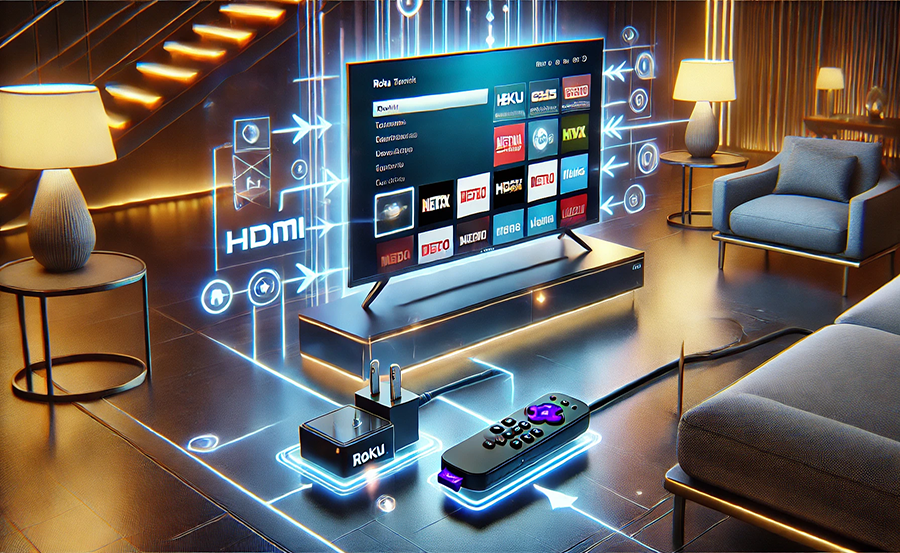Welcome to a detailed guide aimed at simplifying the process of connecting your Roku device to your TV and unlocking a world of entertainment. Whether you’re a tech-savvy individual or someone just starting in the world of streaming, this guide will walk you through every step. We’ll also introduce you to Kemo IPTV, renowned as the best IPTV subscription in the world, bringing you an unmatched viewing experience with an unlimited IPTV subscription. Let’s dive into the details. wants buy 1 Year IPTV Subscription
Setting Up Your Roku: The Basics
Components Required
Before embarking on the journey of connecting your Roku, ensure you have all the necessary components ready. Missing parts can lead to delays or complications.
- Roku device: Of course, the star of the show is your Roku device. Ensure you have the box and all its contents.
- HDMI cable: This cable acts as a bridge between your Roku and TV, delivering high-quality video and audio.
- Power adapter and cable: Essential for powering your Roku device, these should be in the box with your Roku.
- Remote control: A standard Roku remote control, including the necessary batteries, should also be included.
Connecting Your Devices
Once you have all components handy, begin by connecting your Roku to your TV through the HDMI cable. Insert one end of the HDMI cable into the Roku and the other into an available HDMI port on your TV.
TV Settings Configuration
Switch on your TV and set it to the correct HDMI input channel. Your TV should display the Roku logo, signaling that your connection is active. If not, ensure your TV is on the correct input or try another HDMI port.
Powering On Your Roku
Connect your Roku to a power source using the power adapter and cable. A small indicator light should illuminate, confirming power delivery. If the light doesn’t turn on, check your power connection.
Setting Up Your Roku Account and Network
Creating a Roku Account
For your Roku to function fully, a Roku account is necessary. Visit the Roku website to create an account, which involves entering personal details and linking a payment method.
Connecting to Wi-Fi
With your Roku account set up, proceed by connecting your Roku device to your home Wi-Fi network. Using your Roku remote control, navigate through the on-screen instructions, selecting your home network and entering the password.
Troubleshooting Connection Issues
If connectivity issues persist, ensure your router is functioning correctly or try moving your Roku closer to the router. Consult Roku’s support page for additional guidance if needed.
Personalizing Your Roku Experience
Selecting Channels and Apps
With your Roku online, you can personalize it by choosing channels and apps tailored to your viewing preferences. Browse through the extensive selection in the Roku Channel Store.
Using Kemo IPTV
For an unparalleled viewing experience, subscribe to Kemo IPTV. Known for being the best IPTV subscription provider globally, KemoIPTV offers a seamless streaming experience with an Unlimited IPTV Subscription that brings a diverse collection of channels from around the world.
- Access thousands of global channels, ensuring there’s always something to watch.
- Enjoy high-definition streaming with minimal buffering.
- Manage your subscription effortlessly through the user-friendly KemoIPTV interface.
Subscribing to Kemo IPTV
Visit the Kemo IPTV website and select your preferred subscription plan. Follow the steps to set up your account and link it to your Roku device for instant access.
Enhancing Your Viewing Experience
Exploring Advanced Features
Roku offers several advanced features that enhance the viewing experience. These include voice search, private listening, and mobile device control, maximizing convenience and entertainment value.
Setting Up Parental Controls
To keep content appropriate for all viewers in your home, especially children, set up Roku’s parental controls. This ensures that children only access age-appropriate content, allowing you to manage what they watch.
Managing Channel Subscriptions
Stay on top of your channel subscriptions through account settings. Regular management of subscriptions ensures you only pay for services you use, avoiding unnecessary charges.
Common Issues and Solutions
Roku Not Responding
On occasion, your Roku might not respond as expected. Rebooting the device or checking for software updates often resolves these issues.
Buffering and Streaming Quality
Internet speed and connection quality significantly affect streaming performance. Consider upgrading your internet plan or using a wired connection for optimal quality.
Kemo IPTV Streaming Tips
For the best experience with Kemo IPTV, ensure your device settings are optimized for high-definition output, and keep your firmware up-to-date to benefit from the latest features.
Wrapping Up Your Roku Experience
With your Roku now fully configured and equipped with Kemo IPTV, your home is a hub of limitless entertainment. Whether it’s catching up on the latest hit series or exploring global content through an unlimited IPTV subscription, the opportunities are boundless.
Frequently Asked Questions

What should I do if my Roku remote is not working?
If your Roku remote isn’t responding, first try replacing the batteries. If the issue persists, perform a remote reset or purchase a replacement from the Roku website.
Can I use Kemo IPTV on multiple devices?
Yes, Kemo IPTV allows for multiple device connections, enabling you to enjoy its services across various platforms seamlessly.
Do I need a subscription to use Roku?
While many Roku channels offer free content, a subscription is often required for premium channels or services like Kemo IPTV.
How can I improve my Roku’s streaming performance?
Enhance streaming by ensuring a strong internet connection, closing unused applications, and regularly updating your Roku’s software.
What is the difference between Kemo IPTV and traditional cable?
Kemo IPTV offers a broader range of channels, lower cost, and device flexibility compared to traditional cable services, making it an ideal choice for modern viewers.
How to Resolve IPTV Connectivity Issues

